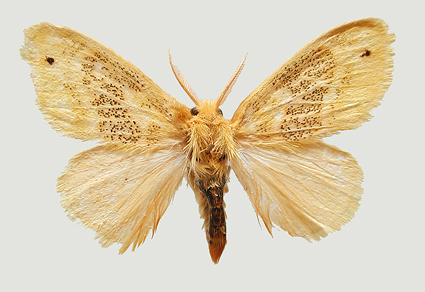Abstract
A new genus Aurivalva Li & Wang gen. nov. is proposed for Nygmiini to accommodate three species previously placed in Euproctis Hübner: A. yunnanpina (Chao, 1984) comb. nov., A. telephanes (Collenette, 1939) comb. nov. and A. conistica (Collenette, 1936) comb. nov.. The new genus is supported by DNA barcodes and morphological evidence. A key to all currently recognized Aurivalva species in China is provided, with illustrations of the adults, wing venations and genitalia, together with a barcode-based tree.
References
- Bali, G.P.K. & Kaleka, A.S. (2023) Report of a tussock moth genus Maeoproctis (Lepidoptera: Erebidae: Lymantriinae: Nygmiini) from India. Journal of Threatened Taxa, 15 (2), 22654–22660. https://doi.org/10.11609/jott.8310.15.2.22654-22660
- Chao, C.L. (1984) New species of the genus Euproctis Hübner from China (Lepidoptera: Lymantriidae). Acta Entomologica Sinica, 27 (4), 449‒456. https://doi.org/10.16380/j.kcxb.1984.04.017
- Chao, C.L. (2003) Lepidoptera Lymantriidae. Fauna Sinica. Insecta 30. Science Press, Beijing, 484 pp.
- Collenette, C.L. (1936) On a collection of Lymantriidae (Heterocera) from North Yunnan. Annals and Magazine of Natural History, Series 10, 17, 333‒337. https://doi.org/10.1080/00222933608655128
- Collenette, C.L. (1939) New Lymantriidae (Lepidoptera, Heterocera) from Asia and the East Indies. Annals and Magazine of Natural History, Series 11, 4 (21), 329‒338. https://doi.org/10.1080/00222933908526997
- Folmer, O., Black, M., Hoeh, W., Lutz, R. & Vrijenhoek, R. (1994) DNA primers for amplification of mitochondrial cytochrome coxidase subunit I from diverse metazoan invertebrates. Molecular Marine Biology and Biotechnology, 3 (5), 294–299.
- Hillis, D.M. & Bull, J.J. (1993) An empirical test of bootstrapping as a method for assessing confidence in phylogenetic analysis. Systematic Biology, 42 (2), 182–192. https://doi.org/10.1093/sysbio/42.2.182
- Holloway, J.D. (1999) The moths of Borneo [Part 5]: family Lymantriidae. Malayan Nature Journal, 53, 1‒188.
- Hübner, J. (1819) Verzeichnis bekannter Schmetterlinge. Bey dem Verfasser zu Finden, Augsburg, 431 pp. https://doi.org/10.5962/bhl.title.48607
- Kimura, M. (1980) A simple method for estimating evolutionary rate of base substitutions through comparative studies of nucleotide sequences. Journal of Molecular Evolution, 16 (2), 111–120. https://doi.org/10.1007/BF01731581
- Kishida, Y. (2011) Descriptions of new species and new subspecies of Japanese Macrolepidoptera (2), with descriptions of 2 new genera. Tinea, 21 (3), 129–135.
- Maes, K. (1984) Some remarks on the genus Euproctis Hübner, [1819] 1816 (Lepidoptera: Lymantriidae). Nota Lepidopterologica, 7 (1), 55–58.
- Rambaut, A. (2018) FigTree. Version 1.4.4. Available from: http://tree.bio.ed.ac.uk/software/figtree (accessed 7 March 2024)
- Speidel, W. & Witt, T.J. (2011) Subfamilia Lymantriinae Hampson, [1893]. In: Witt, T.J. & Ronkay, L. (Eds.), Noctuidae Europaeae. Vol. 13. Lymantriinae and Arctiinae. Entomological Press, Sorø, pp. 45–79.
- Tamura, K., Stecher, G. & Kumar, S. (2021) MEGA 11: molecular evolutionary genetics analysis version 11. Molecular Biology and Evolution, 38 (7), 3022–3027. https://doi.org/10.1093/molbev/msab120
- Trifinopoulos, J., Nguyen, L.T., Haeseler, A. & Minh, B.Q. (2016) W-IQ-TREE: a fast online phylogenetic tool for maximum likelihood analysis, Nucleic Acids Research, 44 (1), 232–235. https://doi.org/10.1093/nar/gkw256
- Wang, H.S., Fan, X.L., Owada, M., Wang, M. & Nylin, S. (2014) Phylogeny, systematics and biogeography of the genus Panolis (Lepidoptera: Noctuidae) based on morphological and molecular evidence. PLoS ONE, 9 (3), e90598. https://doi.org/10.1371/journal.pone.0090598
- Wang, H.S., Wahlberg, N., Holloway, J.D., Bergsten, J., Fan, X.L., Janzen, D.H., Hallwachs, W., Wen, L.J., Wang, M. & Nylin, S. (2015) Molecular phylogeny of Lymantriinae (Lepidoptera, Noctuoidea, Erebidae) inferred from eight gene regions. Cladistics, 31 (6), 579‒592. https://doi.org/10.1111/cla.12108
- Wang, H.S., Wang, M & Fan, X.L. (2011) Notes on the tribe Nygmiini (Lepidoptera: Erebidae: Lymantriinae) from Nanling National Nature Reserve, with description of a new species. Zootaxa, 2887, 57–68. https://doi.org/10.11646/zootaxa.2887.1.3
- Wang, H.S., Xiong, W. & Wang, M. (2010) Two new species of the genus Longipenis (Lepidoptera: Lecithoceridae) from China. Florida Entomologist, 93 (3), 352–356. https://doi.org/10.1653/024.093.0305


